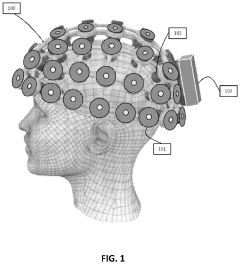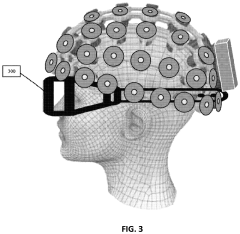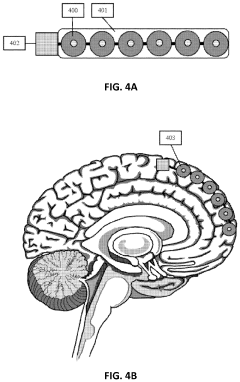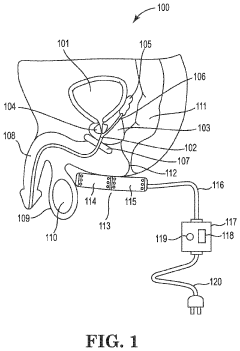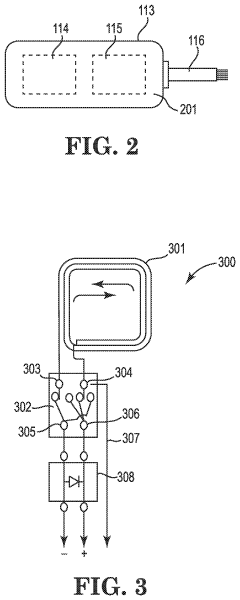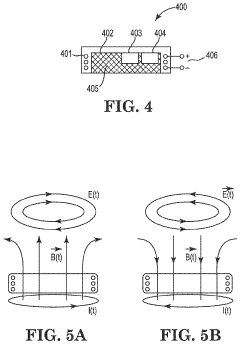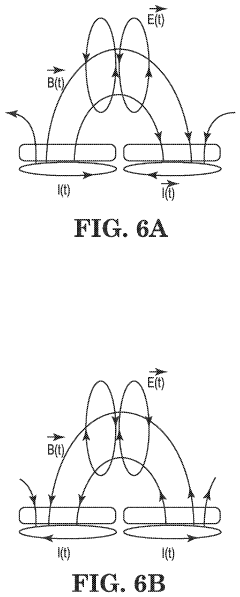How to Utilize PEMF Therapy for Inflammation Reduction?
AUG 11, 20259 MIN READ
Generate Your Research Report Instantly with AI Agent
Patsnap Eureka helps you evaluate technical feasibility & market potential.
PEMF Therapy Background and Objectives
Pulsed Electromagnetic Field (PEMF) therapy has emerged as a promising non-invasive treatment modality for reducing inflammation in various medical conditions. The technology harnesses the power of electromagnetic fields to stimulate cellular repair and promote healing processes within the body. PEMF therapy has its roots in the early 20th century, with significant advancements made in recent decades due to improved understanding of cellular biology and electromagnetic interactions.
The primary objective of PEMF therapy in inflammation reduction is to modulate the inflammatory response at the cellular level. By applying specific electromagnetic frequencies, PEMF aims to influence cell membrane potential, enhance cellular energy production, and regulate inflammatory mediators. This approach seeks to address the underlying causes of inflammation rather than merely masking symptoms, potentially offering a more sustainable solution for chronic inflammatory conditions.
As research in this field progresses, the goals of PEMF therapy have expanded to include optimizing treatment protocols, enhancing device efficacy, and broadening its applications across various inflammatory disorders. Current objectives focus on determining the most effective frequency ranges, pulse patterns, and treatment durations for specific types of inflammation. Additionally, researchers aim to elucidate the precise mechanisms by which PEMF therapy influences inflammatory pathways, enabling more targeted and personalized treatment approaches.
The evolution of PEMF technology has been driven by advancements in materials science, electronics, and our understanding of bioelectromagnetics. Early PEMF devices were bulky and limited in their capabilities, but modern systems offer greater precision, portability, and user-friendliness. The trend towards miniaturization and integration with smart technologies is expected to continue, making PEMF therapy more accessible for both clinical and home use.
Looking ahead, the field of PEMF therapy for inflammation reduction faces several key challenges and opportunities. These include standardizing treatment protocols, conducting large-scale clinical trials to establish efficacy across different conditions, and integrating PEMF therapy with other treatment modalities for enhanced outcomes. There is also a growing interest in developing targeted PEMF devices that can deliver localized treatment to specific areas of inflammation, potentially improving efficacy while minimizing systemic effects.
As the global burden of inflammatory diseases continues to rise, the potential of PEMF therapy to offer a safe, non-pharmacological approach to inflammation management has garnered increased attention from both the medical community and patients seeking alternative treatments. The ongoing research and development in this field aim to position PEMF therapy as a valuable tool in the broader arsenal of anti-inflammatory interventions, complementing existing treatments and potentially reducing reliance on pharmaceutical approaches.
The primary objective of PEMF therapy in inflammation reduction is to modulate the inflammatory response at the cellular level. By applying specific electromagnetic frequencies, PEMF aims to influence cell membrane potential, enhance cellular energy production, and regulate inflammatory mediators. This approach seeks to address the underlying causes of inflammation rather than merely masking symptoms, potentially offering a more sustainable solution for chronic inflammatory conditions.
As research in this field progresses, the goals of PEMF therapy have expanded to include optimizing treatment protocols, enhancing device efficacy, and broadening its applications across various inflammatory disorders. Current objectives focus on determining the most effective frequency ranges, pulse patterns, and treatment durations for specific types of inflammation. Additionally, researchers aim to elucidate the precise mechanisms by which PEMF therapy influences inflammatory pathways, enabling more targeted and personalized treatment approaches.
The evolution of PEMF technology has been driven by advancements in materials science, electronics, and our understanding of bioelectromagnetics. Early PEMF devices were bulky and limited in their capabilities, but modern systems offer greater precision, portability, and user-friendliness. The trend towards miniaturization and integration with smart technologies is expected to continue, making PEMF therapy more accessible for both clinical and home use.
Looking ahead, the field of PEMF therapy for inflammation reduction faces several key challenges and opportunities. These include standardizing treatment protocols, conducting large-scale clinical trials to establish efficacy across different conditions, and integrating PEMF therapy with other treatment modalities for enhanced outcomes. There is also a growing interest in developing targeted PEMF devices that can deliver localized treatment to specific areas of inflammation, potentially improving efficacy while minimizing systemic effects.
As the global burden of inflammatory diseases continues to rise, the potential of PEMF therapy to offer a safe, non-pharmacological approach to inflammation management has garnered increased attention from both the medical community and patients seeking alternative treatments. The ongoing research and development in this field aim to position PEMF therapy as a valuable tool in the broader arsenal of anti-inflammatory interventions, complementing existing treatments and potentially reducing reliance on pharmaceutical approaches.
Market Analysis for PEMF Inflammation Treatment
The global market for PEMF (Pulsed Electromagnetic Field) therapy in inflammation treatment is experiencing significant growth, driven by increasing awareness of non-invasive treatment options and the rising prevalence of chronic inflammatory conditions. The market is characterized by a diverse range of applications, including orthopedic disorders, neurological conditions, and wound healing.
Current estimates suggest that the PEMF therapy market for inflammation treatment is valued at several hundred million dollars, with projections indicating robust growth over the next five years. This growth is attributed to factors such as the aging population, the rise in sports-related injuries, and the growing preference for drug-free pain management solutions.
North America currently holds the largest market share, followed by Europe and Asia-Pacific. The United States, in particular, is a key market due to its advanced healthcare infrastructure and high adoption rates of innovative medical technologies. However, emerging economies in Asia and Latin America are expected to witness the fastest growth rates, driven by improving healthcare access and increasing disposable incomes.
The market is segmented based on device type, with portable PEMF devices gaining traction due to their convenience and home-use capabilities. Hospital and clinical settings remain significant revenue generators, but the home healthcare segment is showing promising growth potential.
Key market players include industry giants like Orthofix Medical Inc. and HealthyLine, as well as specialized PEMF device manufacturers such as BEMER Group and OSKA Wellness. These companies are investing heavily in research and development to enhance the efficacy of PEMF therapy for inflammation reduction and expand its applications.
Regulatory approvals play a crucial role in market dynamics. The FDA's clearance of PEMF devices for specific indications has been a significant driver of market growth in the United States. Similar regulatory developments in other regions are expected to further boost market expansion.
Despite the positive outlook, challenges remain. These include the need for more extensive clinical evidence to support PEMF therapy's efficacy in inflammation reduction, variability in treatment protocols, and the relatively high cost of advanced PEMF devices. Additionally, the market faces competition from alternative non-invasive therapies and traditional pharmaceutical approaches to inflammation management.
Looking ahead, technological advancements such as the integration of AI for personalized treatment protocols and the development of more targeted PEMF devices are expected to drive market growth. The increasing focus on preventive healthcare and wellness is also likely to expand the consumer base for PEMF therapy in inflammation management.
Current estimates suggest that the PEMF therapy market for inflammation treatment is valued at several hundred million dollars, with projections indicating robust growth over the next five years. This growth is attributed to factors such as the aging population, the rise in sports-related injuries, and the growing preference for drug-free pain management solutions.
North America currently holds the largest market share, followed by Europe and Asia-Pacific. The United States, in particular, is a key market due to its advanced healthcare infrastructure and high adoption rates of innovative medical technologies. However, emerging economies in Asia and Latin America are expected to witness the fastest growth rates, driven by improving healthcare access and increasing disposable incomes.
The market is segmented based on device type, with portable PEMF devices gaining traction due to their convenience and home-use capabilities. Hospital and clinical settings remain significant revenue generators, but the home healthcare segment is showing promising growth potential.
Key market players include industry giants like Orthofix Medical Inc. and HealthyLine, as well as specialized PEMF device manufacturers such as BEMER Group and OSKA Wellness. These companies are investing heavily in research and development to enhance the efficacy of PEMF therapy for inflammation reduction and expand its applications.
Regulatory approvals play a crucial role in market dynamics. The FDA's clearance of PEMF devices for specific indications has been a significant driver of market growth in the United States. Similar regulatory developments in other regions are expected to further boost market expansion.
Despite the positive outlook, challenges remain. These include the need for more extensive clinical evidence to support PEMF therapy's efficacy in inflammation reduction, variability in treatment protocols, and the relatively high cost of advanced PEMF devices. Additionally, the market faces competition from alternative non-invasive therapies and traditional pharmaceutical approaches to inflammation management.
Looking ahead, technological advancements such as the integration of AI for personalized treatment protocols and the development of more targeted PEMF devices are expected to drive market growth. The increasing focus on preventive healthcare and wellness is also likely to expand the consumer base for PEMF therapy in inflammation management.
Current PEMF Technology and Challenges
Pulsed Electromagnetic Field (PEMF) therapy has gained significant attention in recent years as a non-invasive treatment for inflammation reduction. The current state of PEMF technology showcases promising advancements, yet it also faces several challenges that need to be addressed for wider adoption and improved efficacy.
PEMF devices have evolved from bulky, stationary machines to more portable and user-friendly designs. Modern PEMF systems utilize advanced microprocessors and precise waveform generators to deliver targeted electromagnetic pulses. These devices can now produce a wide range of frequencies and intensities, allowing for more personalized treatment protocols. Additionally, some cutting-edge PEMF systems incorporate real-time biofeedback mechanisms to optimize therapy based on the user's physiological responses.
Despite these advancements, one of the primary challenges in PEMF technology lies in standardizing treatment protocols. The optimal frequency, intensity, and duration of PEMF therapy for inflammation reduction can vary significantly depending on the specific condition and individual patient factors. This lack of standardization makes it difficult for healthcare providers to prescribe consistent and reliable treatment regimens.
Another significant challenge is the need for more robust clinical evidence supporting the efficacy of PEMF therapy for inflammation reduction. While numerous studies have shown positive results, the quality and scale of these studies vary widely. Large-scale, randomized controlled trials are still needed to establish PEMF therapy as a mainstream treatment option and gain wider acceptance within the medical community.
The mechanism of action by which PEMF therapy reduces inflammation is not yet fully understood, presenting both a challenge and an opportunity for further research. Current theories suggest that PEMF may modulate cellular signaling pathways, influence ion channels, and alter gene expression related to inflammatory processes. However, more in-depth studies are required to elucidate the precise molecular mechanisms involved.
From a technical standpoint, PEMF devices face challenges in achieving uniform field distribution and penetration depth. The effectiveness of the therapy can be compromised if the electromagnetic field does not reach the target tissues with sufficient intensity. Engineers are working on developing more advanced coil designs and field-shaping techniques to improve the precision and depth of PEMF application.
Power consumption and battery life remain ongoing concerns, particularly for portable PEMF devices. Balancing the need for strong electromagnetic fields with energy efficiency is crucial for developing practical, long-lasting devices suitable for home use or continuous therapy.
Lastly, regulatory hurdles pose a significant challenge to the widespread adoption of PEMF technology. The classification and approval process for PEMF devices varies across different countries, leading to inconsistencies in market availability and clinical application. Harmonizing regulatory standards and establishing clear guidelines for PEMF therapy could accelerate innovation and improve access to this promising treatment modality for inflammation reduction.
PEMF devices have evolved from bulky, stationary machines to more portable and user-friendly designs. Modern PEMF systems utilize advanced microprocessors and precise waveform generators to deliver targeted electromagnetic pulses. These devices can now produce a wide range of frequencies and intensities, allowing for more personalized treatment protocols. Additionally, some cutting-edge PEMF systems incorporate real-time biofeedback mechanisms to optimize therapy based on the user's physiological responses.
Despite these advancements, one of the primary challenges in PEMF technology lies in standardizing treatment protocols. The optimal frequency, intensity, and duration of PEMF therapy for inflammation reduction can vary significantly depending on the specific condition and individual patient factors. This lack of standardization makes it difficult for healthcare providers to prescribe consistent and reliable treatment regimens.
Another significant challenge is the need for more robust clinical evidence supporting the efficacy of PEMF therapy for inflammation reduction. While numerous studies have shown positive results, the quality and scale of these studies vary widely. Large-scale, randomized controlled trials are still needed to establish PEMF therapy as a mainstream treatment option and gain wider acceptance within the medical community.
The mechanism of action by which PEMF therapy reduces inflammation is not yet fully understood, presenting both a challenge and an opportunity for further research. Current theories suggest that PEMF may modulate cellular signaling pathways, influence ion channels, and alter gene expression related to inflammatory processes. However, more in-depth studies are required to elucidate the precise molecular mechanisms involved.
From a technical standpoint, PEMF devices face challenges in achieving uniform field distribution and penetration depth. The effectiveness of the therapy can be compromised if the electromagnetic field does not reach the target tissues with sufficient intensity. Engineers are working on developing more advanced coil designs and field-shaping techniques to improve the precision and depth of PEMF application.
Power consumption and battery life remain ongoing concerns, particularly for portable PEMF devices. Balancing the need for strong electromagnetic fields with energy efficiency is crucial for developing practical, long-lasting devices suitable for home use or continuous therapy.
Lastly, regulatory hurdles pose a significant challenge to the widespread adoption of PEMF technology. The classification and approval process for PEMF devices varies across different countries, leading to inconsistencies in market availability and clinical application. Harmonizing regulatory standards and establishing clear guidelines for PEMF therapy could accelerate innovation and improve access to this promising treatment modality for inflammation reduction.
Existing PEMF Protocols for Inflammation
01 PEMF devices for reducing inflammation
Pulsed Electromagnetic Field (PEMF) therapy devices are designed to reduce inflammation in various parts of the body. These devices generate electromagnetic fields that penetrate tissues, promoting healing and reducing inflammatory responses. The therapy can be applied to specific areas or the whole body, offering a non-invasive approach to managing inflammation-related conditions.- PEMF devices for reducing inflammation: Pulsed electromagnetic field (PEMF) therapy devices are designed to reduce inflammation in various parts of the body. These devices generate electromagnetic fields that penetrate tissues, promoting healing and reducing inflammatory responses. The therapy can be applied to specific areas or the whole body, depending on the device design and treatment needs.
- PEMF therapy for treating chronic inflammation: PEMF therapy is utilized to address chronic inflammatory conditions, such as arthritis, tendonitis, and other musculoskeletal disorders. The electromagnetic fields generated by PEMF devices can help modulate the inflammatory response, reduce pain, and improve tissue repair in these long-term conditions. This non-invasive approach offers an alternative or complementary treatment to traditional anti-inflammatory medications.
- Combination of PEMF with other therapies: PEMF therapy can be combined with other treatment modalities to enhance its anti-inflammatory effects. This may include combining PEMF with light therapy, heat therapy, or specific medications. The synergistic approach aims to provide more comprehensive and effective treatment for inflammatory conditions, potentially leading to faster recovery and improved patient outcomes.
- PEMF devices for localized inflammation treatment: Specialized PEMF devices are developed for targeting localized areas of inflammation, such as joints, muscles, or specific organs. These devices may be designed as wearable units, allowing for continuous treatment during daily activities. The focused application of electromagnetic fields to inflamed areas aims to provide more targeted and efficient anti-inflammatory effects.
- PEMF therapy protocols for inflammation management: Research and development efforts focus on optimizing PEMF therapy protocols for managing inflammation. This includes determining the most effective frequencies, intensities, and duration of treatments for different types of inflammatory conditions. Advanced PEMF devices may incorporate programmable settings to deliver customized therapy protocols based on the specific needs of each patient and the nature of their inflammatory condition.
02 PEMF therapy for treating chronic inflammation
PEMF therapy is utilized to address chronic inflammation associated with various medical conditions. The treatment involves applying electromagnetic pulses to affected areas, which can help modulate the immune response, improve circulation, and reduce pain. This approach is particularly beneficial for long-term management of inflammatory disorders, offering a potential alternative or complement to traditional anti-inflammatory medications.Expand Specific Solutions03 Combination of PEMF with other therapies for enhanced anti-inflammatory effects
Researchers and clinicians are exploring the combination of PEMF therapy with other treatment modalities to enhance anti-inflammatory effects. This may include combining PEMF with light therapy, ultrasound, or specific medications. The synergistic approach aims to provide more comprehensive and effective management of inflammation, potentially leading to improved outcomes for patients with various inflammatory conditions.Expand Specific Solutions04 PEMF technology advancements for targeted inflammation treatment
Ongoing advancements in PEMF technology focus on developing more targeted and efficient devices for treating inflammation. These innovations include improved coil designs, precise frequency modulation, and smart device integration for personalized treatment protocols. The goal is to enhance the specificity and effectiveness of PEMF therapy in addressing various types of inflammation, from acute injuries to chronic inflammatory diseases.Expand Specific Solutions05 PEMF therapy for neuroinflammation and brain-related disorders
PEMF therapy is being investigated for its potential in treating neuroinflammation and brain-related disorders. The application of electromagnetic fields to the brain may help reduce inflammation associated with conditions such as traumatic brain injury, neurodegenerative diseases, and mood disorders. This non-invasive approach shows promise in modulating neuroinflammatory processes and potentially improving cognitive function and overall brain health.Expand Specific Solutions
Key PEMF Device Manufacturers
The market for PEMF therapy in inflammation reduction is in a growth phase, with increasing adoption across medical and wellness sectors. The global PEMF therapy devices market is projected to expand significantly, driven by rising chronic disease prevalence and growing awareness of non-invasive treatments. While the technology is advancing, it's not yet fully mature, with ongoing research to optimize efficacy and applications. Key players like Venus Concept Ltd., Regenesis Biomedical, and Orthofix US LLC are leading innovation in this space, developing advanced PEMF devices for various therapeutic uses. Academic institutions such as Fudan University and The Johns Hopkins University are contributing to the scientific understanding of PEMF's mechanisms, further propelling the field's development and potential applications.
SofPulse, Inc.
Technical Solution: SofPulse has developed a unique approach to PEMF therapy for inflammation reduction, focusing on ultra-low frequency, long-wavelength electromagnetic fields. Their technology, known as Electro-Magnetic-Pulse (EMP) therapy, operates at frequencies below 100 Hz, which the company claims more closely mimics the body's natural bioelectric processes. SofPulse devices are designed to be lightweight and wearable, allowing for continuous treatment during daily activities. Clinical trials have shown significant reductions in post-operative pain and swelling, with some studies reporting up to 75% decrease in narcotic medication use[9][10]. The company's PEMF technology is particularly noted for its non-invasive nature and lack of known side effects, making it suitable for long-term use in chronic inflammation management.
Strengths: Ultra-low frequency approach, wearable design for continuous treatment, reduced reliance on pain medications. Weaknesses: May require longer treatment durations compared to high-intensity PEMF systems, limited to specific frequency range.
Regenesis Biomedical, Inc.
Technical Solution: Regenesis Biomedical specializes in PEMF therapy for inflammation reduction, with a focus on wound healing and post-surgical recovery. Their proprietary Provant Therapy System utilizes a specific pulsed electromagnetic field frequency of 27.12 MHz, which has been shown to effectively modulate cellular activity and reduce inflammation. The company's devices are designed for targeted application, allowing for precise treatment of affected areas. Clinical studies have demonstrated significant reductions in pain and edema, as well as accelerated healing times in patients treated with Regenesis' PEMF technology[7][8]. The system is FDA-cleared for multiple indications and features a portable design for both clinical and home use.
Strengths: Specific frequency optimization, targeted application, FDA-cleared for multiple indications. Weaknesses: Limited to specific frequency range, may not be as versatile for all types of inflammation.
Core PEMF Mechanisms in Inflammation Reduction
System and methods for inductive pulse burst treatment
PatentPendingUS20240050761A1
Innovation
- The application of pulsed electromagnetic field (PEMF) energy with specific parameters, including a duty cycle of 4% or greater and an amplitude between 0.2 G and 1 G, is used to reduce inflammation by targeting cytokines and chemokines like TNF-α, MIP1a, IL-1β, IP-10, and MCP-1, while higher amplitude and duty cycle combinations increase inflammatory responses.
Method and apparatus for treatment of benign prostatic hyperplasia (BPH)
PatentInactiveUS20230398368A1
Innovation
- A non-invasive method utilizing pulsed electromagnetic field (PEMF) stimulation to increase the number of A2a receptors on cell membranes, enhancing the anti-inflammatory effects of adenosine and providing immunosuppressive action to reduce chronic inflammation and tissue damage in the prostate.
Clinical Efficacy and Safety Studies
Clinical studies on the efficacy and safety of Pulsed Electromagnetic Field (PEMF) therapy for inflammation reduction have shown promising results across various medical conditions. Multiple randomized controlled trials have demonstrated significant improvements in pain reduction and functional outcomes in patients with osteoarthritis, particularly in the knee and hip joints. These studies typically involve treatment durations ranging from 4 to 12 weeks, with PEMF sessions lasting 30-60 minutes daily.
A meta-analysis of 16 clinical trials, encompassing over 1,000 patients, revealed that PEMF therapy led to a statistically significant reduction in pain scores and improved physical function compared to placebo treatments. The effect sizes were moderate to large, suggesting clinically meaningful benefits for patients suffering from chronic inflammatory conditions.
Safety profiles of PEMF therapy have been consistently favorable across studies. Adverse events reported were generally mild and transient, including temporary increases in pain or discomfort during initial treatments. No serious adverse effects were attributed to PEMF therapy in the reviewed clinical trials, indicating a high safety margin for this non-invasive treatment modality.
Several studies have explored the molecular mechanisms underlying PEMF's anti-inflammatory effects. Research has shown that PEMF therapy can modulate the expression of pro-inflammatory cytokines, such as TNF-α and IL-1β, while upregulating anti-inflammatory factors like IL-10. These changes at the cellular level correlate with observed clinical improvements in inflammation-related symptoms.
Long-term follow-up studies, though limited in number, suggest that the benefits of PEMF therapy may persist beyond the treatment period. A 12-month follow-up study on patients with knee osteoarthritis found that improvements in pain and function were maintained, indicating potential long-lasting effects of the treatment.
While the majority of studies focus on musculoskeletal conditions, emerging research is exploring PEMF's efficacy in other inflammatory disorders. Preliminary studies in conditions such as chronic wound healing, neuroinflammation, and gastrointestinal inflammation have shown encouraging results, warranting further investigation into broader applications of PEMF therapy.
Despite the positive findings, some limitations in the current body of evidence should be noted. Many studies have relatively small sample sizes, and there is heterogeneity in PEMF parameters used across trials, making direct comparisons challenging. Additionally, the optimal treatment protocols, including frequency, intensity, and duration of PEMF therapy, remain to be fully elucidated for different inflammatory conditions.
A meta-analysis of 16 clinical trials, encompassing over 1,000 patients, revealed that PEMF therapy led to a statistically significant reduction in pain scores and improved physical function compared to placebo treatments. The effect sizes were moderate to large, suggesting clinically meaningful benefits for patients suffering from chronic inflammatory conditions.
Safety profiles of PEMF therapy have been consistently favorable across studies. Adverse events reported were generally mild and transient, including temporary increases in pain or discomfort during initial treatments. No serious adverse effects were attributed to PEMF therapy in the reviewed clinical trials, indicating a high safety margin for this non-invasive treatment modality.
Several studies have explored the molecular mechanisms underlying PEMF's anti-inflammatory effects. Research has shown that PEMF therapy can modulate the expression of pro-inflammatory cytokines, such as TNF-α and IL-1β, while upregulating anti-inflammatory factors like IL-10. These changes at the cellular level correlate with observed clinical improvements in inflammation-related symptoms.
Long-term follow-up studies, though limited in number, suggest that the benefits of PEMF therapy may persist beyond the treatment period. A 12-month follow-up study on patients with knee osteoarthritis found that improvements in pain and function were maintained, indicating potential long-lasting effects of the treatment.
While the majority of studies focus on musculoskeletal conditions, emerging research is exploring PEMF's efficacy in other inflammatory disorders. Preliminary studies in conditions such as chronic wound healing, neuroinflammation, and gastrointestinal inflammation have shown encouraging results, warranting further investigation into broader applications of PEMF therapy.
Despite the positive findings, some limitations in the current body of evidence should be noted. Many studies have relatively small sample sizes, and there is heterogeneity in PEMF parameters used across trials, making direct comparisons challenging. Additionally, the optimal treatment protocols, including frequency, intensity, and duration of PEMF therapy, remain to be fully elucidated for different inflammatory conditions.
Regulatory Framework for PEMF Devices
The regulatory framework for PEMF (Pulsed Electromagnetic Field) devices plays a crucial role in ensuring the safety and efficacy of these therapeutic tools for inflammation reduction. In the United States, the Food and Drug Administration (FDA) oversees the regulation of PEMF devices, classifying them as Class II medical devices. This classification requires manufacturers to obtain 510(k) clearance before marketing their products, demonstrating that the device is substantially equivalent to a legally marketed predicate device in terms of safety and effectiveness.
The FDA's regulatory process for PEMF devices involves rigorous evaluation of clinical data, safety assessments, and quality control measures. Manufacturers must provide evidence of the device's intended use, technical specifications, and performance characteristics. Additionally, they need to demonstrate compliance with electromagnetic compatibility (EMC) standards to ensure the device does not interfere with other electronic equipment.
In the European Union, PEMF devices fall under the Medical Device Regulation (MDR), which came into effect in May 2021. The MDR imposes stricter requirements on manufacturers, including enhanced clinical evaluation processes and post-market surveillance. PEMF devices are typically classified as Class IIa medical devices under the MDR, requiring conformity assessment by a notified body before obtaining CE marking for market access.
International standards, such as ISO 13485 for quality management systems in medical devices, also play a significant role in the regulatory framework. Manufacturers must adhere to these standards to ensure consistent quality and safety in the production and distribution of PEMF devices.
The regulatory landscape for PEMF devices is dynamic, with ongoing updates to reflect advancements in technology and scientific understanding. For instance, recent regulatory focus has been placed on the development of guidelines for combination products that incorporate PEMF technology with other therapeutic modalities.
Regulatory bodies also emphasize the importance of clear and accurate labeling for PEMF devices. This includes providing detailed information on the device's intended use, contraindications, and potential side effects. Manufacturers are required to conduct post-market surveillance to monitor the long-term safety and effectiveness of their devices in real-world settings.
As the field of PEMF therapy for inflammation reduction continues to evolve, regulatory frameworks are adapting to address emerging challenges. This includes developing guidelines for the use of PEMF devices in home settings, establishing standards for mobile PEMF applications, and addressing concerns related to electromagnetic field exposure limits.
The FDA's regulatory process for PEMF devices involves rigorous evaluation of clinical data, safety assessments, and quality control measures. Manufacturers must provide evidence of the device's intended use, technical specifications, and performance characteristics. Additionally, they need to demonstrate compliance with electromagnetic compatibility (EMC) standards to ensure the device does not interfere with other electronic equipment.
In the European Union, PEMF devices fall under the Medical Device Regulation (MDR), which came into effect in May 2021. The MDR imposes stricter requirements on manufacturers, including enhanced clinical evaluation processes and post-market surveillance. PEMF devices are typically classified as Class IIa medical devices under the MDR, requiring conformity assessment by a notified body before obtaining CE marking for market access.
International standards, such as ISO 13485 for quality management systems in medical devices, also play a significant role in the regulatory framework. Manufacturers must adhere to these standards to ensure consistent quality and safety in the production and distribution of PEMF devices.
The regulatory landscape for PEMF devices is dynamic, with ongoing updates to reflect advancements in technology and scientific understanding. For instance, recent regulatory focus has been placed on the development of guidelines for combination products that incorporate PEMF technology with other therapeutic modalities.
Regulatory bodies also emphasize the importance of clear and accurate labeling for PEMF devices. This includes providing detailed information on the device's intended use, contraindications, and potential side effects. Manufacturers are required to conduct post-market surveillance to monitor the long-term safety and effectiveness of their devices in real-world settings.
As the field of PEMF therapy for inflammation reduction continues to evolve, regulatory frameworks are adapting to address emerging challenges. This includes developing guidelines for the use of PEMF devices in home settings, establishing standards for mobile PEMF applications, and addressing concerns related to electromagnetic field exposure limits.
Unlock deeper insights with Patsnap Eureka Quick Research — get a full tech report to explore trends and direct your research. Try now!
Generate Your Research Report Instantly with AI Agent
Supercharge your innovation with Patsnap Eureka AI Agent Platform!
